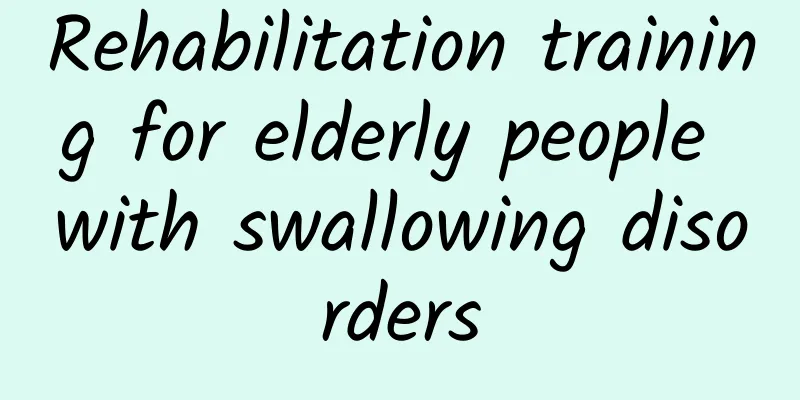Rehabilitation training for elderly people with swallowing disorders

|
Dysphagia refers to difficulty in swallowing food or water. It is one of the common geriatric syndromes. With the accelerated aging of my country's population, the number of patients with swallowing dysfunction caused by aging, stroke, and postoperative pharyngeal and laryngeal tumors is increasing. Dysphagia mainly refers to the feeling of obstruction and stagnation in the pharynx, behind the sternum or behind the xiphoid process caused by the obstruction of food from the mouth to the stomach. Especially dysphagia caused by organic diseases and physiological dysphagia, the latter has no underlying disease, and the patient only feels that there is something blocking the pharynx and behind the sternum, and cannot swallow. | Symptoms of swallowing disorders Dysphagia occurs in different diseases and has different symptoms, the most common of which are as follows: 1. Patients with cerebral infarction may experience dysphagia, which may manifest as choking when drinking water and severe coughing when eating liquid food. They are insensitive to food, water, and mucous membranes, and some of the food may be accidentally swallowed into the trachea, causing aspiration pneumonia and recurrent fever. 2. If dysphagia is caused by a neuromuscular disease, it may be accompanied by difficulty in chewing, so it will be more difficult to swallow hard and dry food. Prolonged eating time, difficulty eating, reduced food intake, malnutrition, and dehydration are all common clinical manifestations. 3. If it is a neuromuscular junction disease, such as dysphagia caused by myasthenia gravis, typical fatigue symptoms will appear. For example, you can eat steamed buns and chew them with strength at the beginning, but then you can only drink porridge. This kind of fluctuating situation will occur. 4. If you have difficulty swallowing and bite your cheeks at the same time, or your speech is unclear, your mouth is crooked, and you drool when you lower your head, it indicates that the facial nerve is affected. | Training methods for swallowing disorders 1. Organ Training 1. Cheek exercise: Close your mouth, puff up your cheeks, hold for 5 seconds, relax, then quickly transfer the air between the left and right cheeks, and repeat 5-10 times. 2. Tongue exercises include extending, retracting, up and down, left and right swinging, and circular movements in the mouth, each lasting 5 seconds and repeated 5-10 times. If conditions do not permit, passive tongue extension exercises can be used instead. 3. Lip exercises: After inhaling, the patient can make sounds such as "wu", "yi", "a", etc., and can purse his lips to blow a balloon or bubbles, etc. By training the lip muscles through pronunciation, the glottal closure function and breathing control can be enhanced. 4. Exercises for the jaw, face and cheeks: Open your mouth as wide as possible, hold for 5 seconds, then relax; move your jaw to the left/right, hold for 5 seconds, then relax, repeat 10 times or make exaggerated chewing movements, repeat 10 times; open your mouth and say "ah" with exaggerated movements, then quickly close your mouth, repeat 10 times; close your mouth, puff out your cheeks, hold for 5 seconds, then relax; open your mouth, lift the tip of your tongue to the back of your front teeth, stick to the hard palate and roll it back, i.e. do the tongue rolling exercise, continue for 5-10 times. 2. Laryngeal lifting exercise For patients who can lift their larynx, let them swallow empty and keep it in the lifted position. When swallowing, let the patient press the tongue against the hard palate, hold their breath, and keep this position for a few seconds. At the same time, let the patient place the index finger above the thyroid cartilage and the middle finger on the cricoid cartilage to feel the larynx lift. For patients who are unable to lift their larynx, you can massage their neck and push up the larynx to promote swallowing. 3. Cold stimulation Use a tongue depressor to stimulate the back of the tongue root. Use a cold cotton swab to stimulate the posterior pharyngeal wall, palatal arch, posterior tongue root, and soft palate every morning, noon, and evening to induce swallowing reflex. If choking or nausea occurs, stop stimulating. Swallow during cold stimulation. If drooling is excessive, cold stimulation can be applied to the salivary glands on the affected side of the neck, 3 times a day, 10 minutes each time, until the skin turns slightly red. 4. Feeding Training Feeding Training It is suitable for patients with clear consciousness, stable condition, swallowing reflex, and the ability to cough out a small amount of accidental swallowing. The specific method is as follows: 1. When eating, sit instead of lying down if possible; eat at the dining table instead of the bedside. For patients who cannot sit up, raise the head of the bed at least 30 degrees, bend the head forward, and the feeder should be on the healthy side. 2. Feeding method (1) Feed the patient while standing on the healthy side, starting with 1-4 ml. Place the food bolus behind the healthy tongue or on the healthy cheek. The amount an adult should eat at a time should not exceed 300 ml. Do not turn the patient over, pat the back, or suction sputum within 30 minutes after eating. (2) Empty swallowing: After swallowing food each time, do a few empty swallows to make sure all the food is swallowed before moving on to the next step of feeding. (3) Alternative swallowing: Let the patient swallow solid food and liquid food alternately, or feed a small amount of water (1-2 ml) after each swallow. This is conducive to stimulating the swallowing reflex and achieving the purpose of removing food retained in the pharynx, but be careful to avoid accidents such as choking and aspiration. (4) Nodding swallowing: When the neck is tilted back, the epiglottic trough becomes narrower, which can squeeze out retained food. Then lower the head and make swallowing movements. Repeat this several times to clear and swallow the retained food. (5) Lateral swallowing: The piriformis recess is another area where food is easily retained after swallowing. By nodding the chin to the left or right, the food retained in the piriformis recess on both sides can be removed and swallowed. 3. Food selection: Choose food that is easy for patients to accept based on their eating habits and the severity of their swallowing difficulties. Patients with poor chewing ability should eat less meat or other solid foods and choose more foods that are easy to swallow, such as vegetable puree, egg custard, thick soup, etc. Clean the oral cavity and pharynx before and after eating to reduce lung infection. Dysphagia is very frustrating, but it takes a long time to recover. You must persist in rehabilitation training. Only by persisting in training can you have hope of recovery. If the patient is in a bad mood, he should learn to relax in time, listen to more music, watch movies, and chat with good friends, which will be more conducive to the treatment of dysphagia. |
<<: Home rehabilitation for elderly people with dementia
>>: Eezeer: Twitter usage among airlines in August 2011
Recommend
A pimple grew in the private part
If you have a rash on your private part, the firs...
Does the electric blanket have radiation to pregnant women?
When the weather is cold, people will use various...
How long after giving birth can I climb stairs?
After a woman gives birth, if it is a natural bir...
How long does it take for breast pain to occur during pregnancy?
Breast disease is a type of disease that currentl...
[Medical Q&A] Does a test report showing abnormal myocardial enzyme spectrum mean myocardial infarction?
Planner: Chinese Medical Association Reviewer: Ni...
What is the reason for blood in urine?
Many friends expressed that they did not know wha...
Can women with moderate cervical erosion have children?
As we all know, there are many kinds of gynecolog...
The best treatment for pubic lice, eight methods to teach you
The presence of pubic lice indicates that persona...
Is it better to apply heat or cold to knee pain?
Whether hot or cold compress is better for knee p...
What are the advantages of the anterior placenta?
In a normal pregnancy, the placenta is attached t...
Can yoga treat menstrual disorders in women?
Irregular menstruation is one of the more common ...
What is the best medicine for anal fissure in women?
When it comes to anal fissures, many of my friend...
Why do I have leucorrhea every day?
Before we get into the details, I want to ask you...
Jia Ling lost 100 pounds and became a hot topic! Rapid weight loss is not advisable. If you want to lose weight scientifically, please read these 20 tips
The first big shock of 2024! Jia Ling lost 100 po...
Reasons for heavy menstrual flow in the second month after abortion
Abortion has a great impact on women's physic...









